Joanna of Castile
| Joanna | |
|---|---|
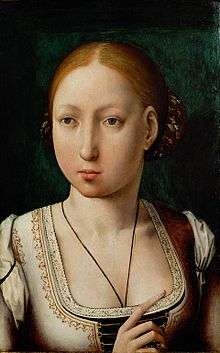 Portrait by Juan de Flandes, c. 1500 | |
| Queen of Castile and León | |
| Reign |
26 November 1504 – 12 April 1555 |
| Predecessors | Isabella I and Ferdinand V |
| Successor | Charles I |
| Co-monarchs |
Philip I Charles I |
| Regents |
See
|
| Queen of Aragon | |
| Reign |
23 January 1516 – 12 April 1555 |
| Predecessor | Ferdinand II |
| Successor | Charles I |
| Co-monarch | Charles I |
| Regent | Charles I |
| Born |
6 November 1479 Toledo, Spain |
| Died |
12 April 1555 (aged 75) Tordesillas, Spain |
| Burial | Capilla Real, Granada, Spain |
| Spouse | Philip I of Castile |
| Issue |
Eleanor, Queen of Portugal, and France Charles V, Holy Roman Emperor Isabella, Queen of Denmark, Norway and Sweden Ferdinand I, Holy Roman Emperor Mary, Queen of Hungary and Bohemia Catherine, Queen of Portugal |
| House | Trastámara |
| Father | Ferdinand II of Aragon |
| Mother | Isabella I of Castile |
| Religion | Roman Catholicism |
Joanna of Castile (6 November 1479 – 12 April 1555), called the Mad (Spanish: Juana la Loca), was queen of Castile from 1504 and of Aragon from 1516. From the union of these two crowns modern Spain evolved.[1] Joanna married Philip the Handsome on October 20, 1496. Philip was crowned King of Castile in 1506, initiating the rule of the Habsburgs in Spain. After Philip's death that same year, Joanna was deemed mentally ill and was confined to a nunnery for the rest of her life. Though she remained the legal queen of Castile throughout this time, her father, Ferdinand II of Aragon, was regent until his death, when she inherited his kingdom as well. From 1517, her son, Charles, ruled as king, while she nominally remained co-monarch.
Life before accession
Early life
Joanna was born in the city of Toledo, the capital of the Kingdom of Castile. She was the third child and second daughter of Isabella I of Castile and Ferdinand II of Aragon of the royal House of Trastámara. Joanna had been a clever and diligent child and an excellent student. Queen Isabella came to ensure that Joanna along with her three sisters Isabella, Maria, and Catherine received a fine education .[2] Her academic education consisted of canon and civil law, genealogy and heraldry, grammar, history, languages, mathematics, philosophy, reading, spelling, and writing.[3] She read an impressive list of authors of classical literature that included the Christian poets Juvencus and Prudentius, Church fathers Saint Ambrose, Saint Augustine, Saint Gregory, and Saint Jerome, and the Roman statesman Seneca.[3] In the Castilian court her main tutors were the Dominican priest Andrés de Miranda, the respected educator Beatriz Galindo who was a member of the queen's court, and her mother the queen. Joanna developed feminine accomplishments in court etiquette, dancing, drawing, equestrian skills, good manners, music, and the needle arts of embroidery, needlepoint, and sewing.[3] She excelled in all of the Iberian Romance languages: Castilian, Leonese, Galician-Portuguese, and Catalan and had been fluent in French and Latin. Joanna had been given instruction in religious studies and she had learned outdoor pursuits such as hawking and hunting. Praise was given to her for being a skilled dancer and a talented musician in playing the clavichord, the guitar, and the monochord. She was educated and formally trained for a significant marriage that, as a royal family alliance, would extend the kingdoms' power and security as well as its influence and peaceful relations with other ruling powers. As an infanta she was not expected to be heiress to the throne of either Castile or Aragon, although through deaths she later inherited both. She had a fair complexion, blue eyes and her hair colour was between strawberry-blonde and auburn, like her mother and sister Catherine. Already in 1495 Joanna showed signs of religious skepticism and little devotion to worship and Christian rites. This alarmed her mother, who ordered it to be kept secret. English ambassadors at Valencia on 23 June 1505 attempted to give a detailed description of her appearance according to fifteen criteria, though her clothing hampered their estimation.[4]
Marriage

In 1496, Joanna, at the age of sixteen, was betrothed to Philip the Handsome, Duke of Burgundy (titular), in the region of Flanders in the Low Countries. Philip's parents were Maximilian I, Holy Roman Emperor and his first wife, Duchess Mary of Burgundy. The marriage was one of a set of family alliances between the Habsburgs and the Trastámaras designed to strengthen both against growing French power. Joanna entered a proxy marriage at the Palacio de los Vivero in the city of Valladolid, Castile (her parents had secretly married there in 1469). In August 1496 Joanna left from the port of Laredo in northern Spain on the Atlantic's Bay of Biscay. She would not see her siblings again except for her younger sister Catherine of Aragon in 1506, who was then the Princess Dowager of Wales. Joanna began her journey to Flanders in the Low Countries, which consisted of parts of the present day Netherlands, Belgium, Luxembourg, France, and Germany, on 22 August 1496. The formal marriage took place on 20 October 1496 in Lier,[5] north of present-day Brussels. Between 1498 and 1507, she gave birth to six children: two emperors and four queens.[5]
Princess of Asturias
The death of Joanna's brother John, the stillbirth of John's daughter and the deaths of Joanna's older sister Isabella and Isabella's son Miguel made Joanna heiress to the Spanish kingdoms. Her remaining siblings were Maria (1482–1517) and Catherine (1485–1536), younger than Joanna by three and six years, respectively. In 1502, the Castilian Cortes of Toro[6][7][8] recognised Joanna as heiress to the Castilian throne and Philip as her consort. She was named Princess of Asturias, the title traditionally given to the heir of Castile.[9] Also in 1502, the Aragonese Cortes gathered in Zaragoza to swear an oath to Joanna as heiress; however, the Archbishop of Saragossa expressed firmly that this oath could only establish jurisprudence by way of a formal agreement on the succession between the Cortes and the king.[10][11]
In 1502, Philip, Joanna and a large part of the Burgundian court travelled to Spain for Joanna to receive fealty from the Cortes of Castile as Princess of Asturias, heiress to the Castilian throne, a journey chronicled in great detail by Antoon I van Lalaing (French: Antoine de Lalaing). Philip and the majority of the court returned to the Low Countries in the following year, leaving a pregnant Joanna in Madrid where she gave birth to her and Philip's fourth child, Ferdinand, later a central European monarch and Holy Roman Emperor as Ferdinand I.
Reign

Queen of Castile
Succession
Upon the death of her mother in November 1504, Joanna became Queen regnant of Castile and her husband jure uxoris its king. Joanna's father, Ferdinand II, lost his monarchical status in Castile although his wife's will permitted him to govern in Joanna's absence or, if Joanna was unwilling to rule herself, until Joanna's heir reached the age of 20. Ferdinand refused to accept this: he minted Castilian coins in the name of "Ferdinand and Joanna, King and Queen of Castile, León and Aragon," and, in early 1505, persuaded the Cortes that Joanna's "illness is such that the said Queen Doña Joanna our Lady cannot govern". The Cortes then appointed Ferdinand as Joanna's guardian and the kingdom's administrator and governor. However, her husband Philip the Handsome was unwilling to accept any threat to his chances of ruling Castile and also minted coins in the name of "Philip and Joanna, King and Queen of Castile, Léon and Archdukes of Austria, etc."[12] In response, Ferdinand embarked upon a pro-French policy, marrying Germaine de Foix, niece of Louis XII of France (and his own great-niece), in the hope that she would produce a son to inherit Aragon and perhaps Castile.[13]
Ferdinand's remarriage merely strengthened support for Philip and Joanna in Castile, and in late 1505, the pair decided to travel to Castile. Leaving Flanders on 10 January 1506, their ships were wrecked on the English coast and the couple were guests of Henry, Prince of Wales, later Henry VIII and Joanna's sister Catherine of Aragon at Windsor Castle. They weren't able to leave until 21 April by which time civil war was looming in Castile. Philip apparently considered landing in Andalusia and summoning the nobles to take up arms against Ferdinand in Aragon. Instead, he and Joanna landed at A Coruña on 26 April, whereupon the Castilian nobility abandoned Ferdinand en masse. Ferdinand met Philip at Villafáfila on 20 June 1506 and handed over the government of Castile to his "most beloved children", promising to retire to Aragon. Philip and Ferdinand then signed a second treaty, agreeing that Joanna's mental instability made her incapable of ruling and promising to exclude her from government. Ferdinand then proceeded to repudiate the agreement the same afternoon, declaring that Joanna should never be deprived of her rights as Queen Proprietress of Castile. A fortnight later, having come to no fresh agreement with Philip and thus effectively retaining his right to interfere if he considered his daughter's rights to have been infringed upon, he abandoned Castile for Aragon, leaving Philip to govern in Joanna's stead.[14]
Philip's death
By virtue of the agreement of Villafáfila, the procurators of the Cortes met in Valladolid, Castile on 9 July 1506. On 12 July,[15][16] they swore allegiance to Philip I and Joanna together as King and Queen of Castile and León and to their son Charles, later Charles I of Castile, Leon and Aragon and Charles V, Holy Roman Emperor, as their heir-apparent.[17] This arrangement only lasted for a few months. On 25 September 1506 Philip died suddenly of typhoid fever in the city of Burgos in Castile. Some suspected that he had been poisoned by his father-in-law Ferdinand II who had always disliked his foreign Habsburg origins and with whom he never wanted to share power. Joanna was pregnant with their sixth child, a daughter named Catherine (1507–1578), who later became Queen of Portugal. By 20 December 1506 Joanna was in the village of Torquemada in Castile, attempting to exercise her rights to rule alone in her own name as Queen of Castile. The country fell into disorder. Her son and heir-apparent, Charles, later Charles I, was a six-year-old child being raised in his aunt's care in northern European Flanders; her father, Ferdinand II, remained in Aragon, allowing the crisis to grow. A regency council under Archbishop Cisneros was set up against the queen's orders but it was unable to manage the growing public disorder; plague and famine devastated the kingdom with supposedly half the population perishing of one or the other. The queen was unable to secure the funds required to assist her to protect her power. In the face of this, Ferdinand II returned to Castile in July 1507. His arrival coincided with a remission of the plague and famine, a development which quieted the instability and left an impression that his return had restored the health of the kingdom.[18]
Father's regency
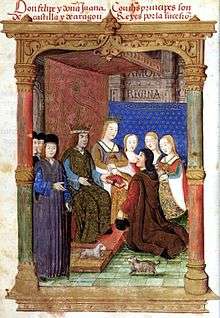
Ferdinand II and Joanna met at Hornillos, Castile on 30 July 1507. Ferdinand then constrained her to yield up her power over the Kingdom of Castile and León to himself. On 17 August 1507 she summoned three members of the royal council and ordered them to inform the grandees, in her name, of her father Ferdinand II's return to power: "That they should go to receive his highness and serve him as they would her person and more." She refused to sign the instructions – a last gesture of defiance – and issued a statement that she did not, as queen regnant, endorse the surrender of her own royal power. Nonetheless, she was thereafter queen in name only and all documents, though issued in her name, were signed with Ferdinand's signature, "I the King". He was named administrator of the kingdom by the Cortes of Castile in 1510, and entrusted the government mainly to Archbishop Cisneros. He had Joanna confined in the Santa Clara convent in Tordesillas, near Valladolid in Castile, in February 1509 after having dismissed all of her faithful servants and having appointed a small retinue accountable to him alone.[9] At this time, some accounts claim that she was insane or "mad", and that she took her husband's corpse with her to Tordesillas to keep it close to her.[14]
First Queen of Spain
Succession as Queen of Aragon
Ferdinand II ended his days embittered: his second marriage had failed to produce a surviving male heir leaving his daughter Joanna as his heiress-presumptive. Ferdinand resented that, upon his death, Castile and Aragon would effectively pass to his foreign-born-and-raised grandson Charles I, to whom he had transferred his hatred of Philip I. He had hoped that his younger grandson and namesake, Ferdinand I, who was Charles I's brother and had been born and raised in Castile, would succeed him. Ferdinand II had named Ferdinand as his heir in his will before being persuaded to revoke this bequest and rename Joanna and Charles I as his heirs-presumptive instead. When Ferdinand II died in 1516, the Kingdoms of Castile and León, and Aragon and their associated crowns and territories/colonies would pass to Joanna I and Charles I.[19] With Charles I still in Flanders, Aragon was being governed after Ferdinand II's death by his bastard son, Alonso de Aragón. Meanwhile, Castile and León, already subjects of Joanna, were governed by Archbishop Cisneros as regent. A group of nobles, led by the Duke of Infantado, attempted to proclaim the Infante Ferdinand as King of Castile but the attempt failed.
Son as co-monarch
In October 1517, seventeen-year-old Charles I arrived in Asturias at the Bay of Biscay. On 4 November, he and his sister Eleanor met their mother Joanna at Tordesillas – there they secured from her the necessary authorisation to allow Charles to rule as her co-King of Castile and León and of Aragon. Despite her acquiescence to his wishes her confinement would continue. The Castilian Cortes, meeting in Valladolid, spited Charles by addressing him only as Su Alteza ("Your Highness") and reserving Majestad ("Majesty") for Joanna.[20] However, no one seriously considered rule by Joanna a realistic proposition.[21]
In 1519 Charles I now ruled the Kingdom of Aragon and its territories and the Kingdom of Castile and León and its territories, in personal union. In addition, that same year Charles was elected Holy Roman Emperor. The kingdoms of Castile and Aragon (and Navarre) remained in personal union until their jurisdictional unification in the early 18th century by the Bourbons while Charles eventually abdicated as Emperor of the Holy Roman Empire in favour of his brother Ferdinand and the personal union with the Spanish kingdoms was dissolved.
Revolt of the Comuneros
In 1520, the Revolt of the Comuneros broke out in response to the perceived foreign Habsburg influence over Castile through Charles V. The rebel leaders demanded that Castile be governed in accordance with the supposed practices of the Catholic Monarchs. In an attempt to legitimise their rebellion, the Comuneros turned to Joanna. As the 'on record' sovereign monarch, had she given written approval to the rebellion, it would have been legalised and would have triumphed. In an attempt to prevent this, Don Antonio de Rojas, Bishop of Mallorca, led a delegation of royal councillors to Tordesillas, asking Joanna to sign a document denouncing the Comuneros. She demurred, requesting that he present her specific provisions. Before this could be done the Comuneros in turn stormed the virtually undefended city and requested her support. The request prompted Adrian of Utrecht, the regent appointed by Charles V, to declare that Charles would lose Castile if she granted her support. Although she was sympathetic to the Comuneros, she was persuaded by Ochoa de Landa and her confessor Fray John of Avila that supporting the revolt would irreparably damage the country and her son's kingship and she therefore refused to sign a document granting her support.[22] The Battle of Villalar confirmed that Charles would prevail over the revolt.
Forced confinement
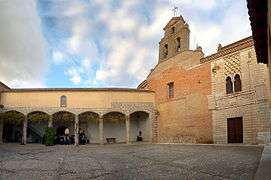
Charles ensured his domination and throne by having his mother confined for the rest of her life in the rooms of the Convent of Santa Clara in Tordesillas, Castile. Joanna's condition degenerated further. She apparently became convinced that some of the nuns of the convent wanted to kill her, a fear which was never proved. Reportedly it was difficult for her to eat, sleep, bathe, or change her clothes. Charles wrote to the Convent of Santa Clara caretakers: "It seems to me that the best and most suitable thing for you to do is to make sure that no person speaks with Her Majesty, for no good could come from it".[23]
Joanna had her youngest daughter, Catherine of Austria, with her during Ferdinand II's time as regent, 1507–1516. Her older daughter, Eleanor of Austria, had created a semblance of a household within the convent rooms. In her final years, Joanna's physical state began to decline rapidly with mobility ever more difficult.
Joanna died on Good Friday, 12 April 1555 at the age of 75 in the Convent of Santa Clara at Tordesillas.[9] She is entombed in the Royal Chapel of Granada (la Capilla Real) in Spain alongside her parents Isabella I and Ferdinand II, her husband Philip I and her nephew Miguel da Paz, Prince of Asturias. A statue of her stands in Tordesillas and the convent in which she was confined for fifty years can be visited.
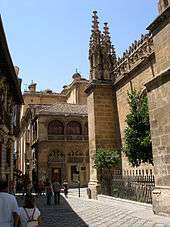
Mental health
As a young woman, she was known to be highly intelligent. It was only after her marriage that the first suspicions of mental illness arose. One reason for this may be due to the sympathy she showed for Martin Luther's ideas.[24] Some historians comment that she may have suffered from melancholia, a depressive disorder, a psychosis, or a case of inherited schizophrenia.[25]:9 There is debate about the diagnosis that she was mentally ill. Joanna's symptoms were perhaps aggravated by her non-consensual confinement and control by others who had assumed her royal powers to legitimise the claims of her husband, father, and son to the throne. Joanna was nominalised as Queen regnant of Castile, León, and Aragon until her death. It is possible that she inherited mental illness from her mother's family: her maternal grandmother Isabella of Portugal, Queen of Castile suffered from this condition in widowhood after her stepson exiled her to the castle of Arévalo in Ávila, Castile.[25]:12[26]
Legacy in arts and letters
The story of Queen Joanna attracted authors, composers and artists of the 19th-century romanticist movement, with her qualities of unrequited love and moral fidelity. Later authors often focus on the grief-stricken woman and her mental illness. An incomplete list of these works follows:
- Felipe el Hermoso (1845) — Eusebio Asquerino and Gregorio Romero. A play in four acts.
- La Locura de Amor (1855) – Manuel Tamayo y Baus. Play.
- Doña Juana la Loca (1890) – Emilio Serrano. Opera.
- Juana la Loca (1877) – Francisco Pradilla. Painting. Currently in the Prado museum of Madrid, Spain.
- Locura de amor (1948) – Juan de Orduña. Film.
- The Prisoner of Tordesillas (1959) – Lawrence Schoonover. Novel.
- Terra Nostra (1975) – Carlos Fuentes. Novel.
- La Loca (1979) – Gian Carlo Menotti. Opera.
- Mariner by the playwright Don Nigro. Play.
- Un amour fou (1991) – Catherine Hermary-Vieille. Novel.
- Las Ruinas del Corazón (1999) – Eric Gamalinda. Poem.
- Juana la Loca (2001) – directed by Vicente Aranda and starring Pilar López de Ayala as Joanna, was nominated for 12 Goya Awards, and was released in the US as Mad Love. Based on La Locura de Amor by Manuel Tamayo y Baus.
- Rage d'amours (2003) – Robert Zuidam. Opera premiered at the Tanglewood Music Festival, 10 August 2003.[27]
- El Pergamino de la Seducción (2005) – Gioconda Belli. Novel in Spanish.
- Juana (2005) – Enric Palomar. Chamber opera in three acts, premiered at the Oper Halle, 25 June 2005.[28]
- The Last Queen (2007) – C.W. Gortner. Novel in English and Spanish
Arms
|
Children

| Name | Birth | Death | Notes |
|---|---|---|---|
| Eleanor | 15 November 1498 | 25 February 1558 (aged 59) | married firstly in 1518, Manuel I of Portugal and had children; married secondly in 1530, Francis I of France and had no children. |
| Charles | 24 February 1500 | 21 September 1558 (aged 58) | married in 1526, Isabella of Portugal and had children. |
| Isabella | 18 July 1501 | 19 January 1526 (aged 24) | married in 1515, Christian II of Denmark and had children. |
| Ferdinand | 10 March 1503 | 25 July 1564 (aged 61) | married in 1521, Anna of Bohemia and Hungary and had children. |
| Mary | 18 September 1505 | 18 October 1558 (aged 53) | married in 1522, Louis II of Hungary and Bohemia and had no children. |
| Catherine | 14 January 1507 | 12 February 1578 (aged 71) | married in 1525, John III of Portugal and had children. |
All Joanna's children except Mary had children. However, only Charles, Isabella and Ferdinand have descendants today.
Ancestry
References
- ↑ Fueros, observancias y actos de corte del Reino de Aragón; Santiago Penén y Debesa, Pascual Savall y Dronda, Miguel Clemente (1866), page 64
- ↑ Gelardi, p.61
- 1 2 3 Gelardi, p. 61
- ↑ "''Calendar State Papers Spain'', vol. 1 (1862), no. 436". British-history.ac.uk. 22 June 2003. Retrieved 22 August 2012.
- 1 2 marcalcide. "The marriage of Philip I of Castile". Youtube.com. Retrieved 22 August 2012.
- ↑ "''Cortes de los antiguos reinos de León y de Castilla''; Manuel Colmeiro (1883)". Cervantesvirtual.com. Retrieved 23 August 2012.
- ↑ "Capítulo XXII". Cervantesvirtual.com. 29 November 2010. Retrieved 23 August 2012.
- ↑ Estudio documental de la moneda castellana de Juana la Loca fabricada en los Países Bajos (1505–1506); José María de Francisco Olmos, page 303 Archived 14 January 2012 at the Wayback Machine.
- 1 2 3 Aram, Bethany. (1998) "Juana 'the Mad's' Signature: The Problem of Invoking Royal Authority, 1505-1507" Sixteenth Century Journal, 29(2), 331-358. doi:10.2307/2544520
- ↑ Estudio documental de la moneda castellana de Carlos I fabricada en los Países Bajos (1517); José María de Francisco Olmos, page 137 Archived 5 February 2012 at the Wayback Machine.
- ↑ Estudio documental de la moneda castellana de Juana la Loca fabricada en los Países Bajos (1505–1506); José María de Francisco Olmos, page 299 Archived 14 January 2012 at the Wayback Machine.
- ↑ Estudio documental de la moneda castellana de Juana la Loca fabricada en los Países Bajos (1505–1506); José María de Francisco Olmos, page 315 Archived 14 January 2012 at the Wayback Machine.
- ↑ Elliott, JH, Imperial Spain, p.138; "Juana 'the Mad's' Signature," Bethany Aram, from Sixteenth Century Journal.
- 1 2 Elliott, JH, Imperial Spain, p.139
- ↑ "''Cortes de los antiguos reinos de León y de Castilla''; Manuel Colmeiro (1883)". Cervantesvirtual.com. 29 November 2010. Retrieved 23 August 2012.
- ↑ "Capítulo XXIII". Cervantesvirtual.com. 29 November 2010. Retrieved 23 August 2012.
- ↑ "Estudio documental de la moneda castellana de Carlos I fabricada en los Países Bajos (1517); José María de Francisco Olmos" (PDF). p. 135. Archived from the original (PDF) on 26 May 2006.
- ↑ Elliott, JH, Imperial Spain, p.139; "Juana 'the Mad's' Signature", Bethany Aram, from Sixteenth Century Journal
- ↑ "Estudio documental de la moneda castellana de Carlos I fabricada en los Países Bajos (1517); José María de Francisco Olmos" (PDF). p. 138. Archived from the original (PDF) on 26 May 2006.
- ↑ "Estudio documental de la moneda castellana de Carlos I fabricada en los Países Bajos (1517); José María de Francisco Olmos" (PDF). p. 144. Archived from the original (PDF) on 26 May 2006.
- ↑ Elliott, JH, Imperial Spain, pp.143–146
- ↑ Seaver, Henry Latimer (1966) [1928], The Great Revolt in Castile: A study of the Comunero movement of 1520–1521, New York: Octagon Books, p. 359
- ↑ Waldherr, Kris (28 October 2008). Doomed Queens: Royal Women Who Met Bad Ends, From Cleopatra to Princess Di. Crown Publishing Group. p. 113. ISBN 978-0-7679-3103-8.
- ↑ « Il n'y a pas de jour, écrivait-il, que nous ne nous occupions de l'affaire de la messe. » (Letter from marquis de Dénia, 3 July 1518).
- 1 2 María A. Gómez; Santiago Juan-Navarro; Phyllis Zatlin (2008), Juana of Castile: history and myth of the mad queen (illustrated ed.), Associated University Presse, pp. 9, 12–13, 85, ISBN 9780838757048
- ↑ Louda, Jirí and Michael MacLagan. Lines of Succession: Heraldry of the Royal Families of Europe, 2nd edition. London, U.K.: Little, Brown and Company, 1999.
- ↑ Rage d'amours page on composer's site. Accessed 25 February 2015.
- ↑ Profile of the work on mondigromax.com. Accessed 25 February 2015.
- 1 2 Felipe I el Hermoso: La belleza y la locura. Madrid: Fundación Carlos de Amberes. 2006. ISBN 84-934643-3-3. Retrieved 19 March 2013.
- 1 2 3 Menéndez-Pidal De Navascués, Faustino (1999) El escudo; Menéndez Pidal y Navascués, Faustino; O'Donnell, Hugo; Lolo, Begoña. Símbolos de España. Madrid: Centro de Estudios Políticos y Constitucionales. ISBN 84-259-1074-9
- ↑ Image at Santa María la Real Church Facade, Aranda de Duero, Burgos (Spain)
- ↑ She was the daughter John of Gaunt, 1st Duke of Lancaster to his first wife Blanche of Lancaster, making her half-sister of Katherine of Aragon's maternal great-grandmother Katherine of Lancaster, daughter of Gaunt to his second wife Constance of Castile.
Bibliography
- Biographies
- W. H. Prescott, Hist. of Ferdinand and Isabella (1854)
- Rosier, Johanna die Wahnsinnige (1890)
- H. Tighe, A Queen of Unrest (1907).
- R. Villa, La Reina doña Juana la Loca (1892)
- Bethany Aram, Juana the Mad: Sovereignty and Dynasty in Renaissance Europe (Baltimore, Johns Hopkins UP, 2005).
- Adriana Assini, Le rose di Cordova, Scrittura & Scritture, Napoli 2007
- Works cited
- Miller T. The Castles and the Crown. Coward-McCann: New York, 1963
- Aram, Bethany, "Juana "the Mad's" Signature: The Problem of Invoking Royal Authority, 1505- 1507", Sixteenth Century Journal
- Elliott, J.H., Imperial Spain, 1469–1716
- de Francisco Olmos, José María: Estudio documental de la moneda castellana de Juana la Loca fabricada en los Países Bajos (1505–1506), Revista General de Información y Documentación 2002, vol 12, núm.2 (Universidad complutense de Madrid).
- de Francisco Olmos, José María: Estudio documental de la moneda castellana de Carlos I fabricada en los Países Bajos (1517); Revista General de Información y Documentación 2003, vol 13, núm.2 (Universidad complutense de Madrid).
- Juan-Navarro, Santiago, Maria Gomez, and Phyllis Zatlin. Juana of Castile: History and Myth of the Mad Queen. Newark and London: Bucknell University Press, 2008.
External links
| Wikimedia Commons has media related to Joanna of Castile. |
| Joanna of Castile Born: 6 November 1479 Died: 12 April 1555 | ||
| Regnal titles | ||
|---|---|---|
| Preceded by Isabella I Ferdinand V |
Queen of Castile and León 1504–1555 with Philip I (1506) Charles I (1516–1555) |
Succeeded by Charles I |
| Preceded by Ferdinand II |
Queen of Aragon, Sicily, Valencia, Majorca and Naples; Countess of Barcelona, Roussillon and Cerdagne 1516–1555 with Charles I (1516–1555) | |
| Spanish royalty | ||
| Vacant Title last held by Miguel of Portugal |
Princess of Girona 1502–1509 |
Succeeded by John of Aragon |
| Princess of Asturias 1502–1504 |
Succeeded by Charles of Austria | |
| Preceded by John of Aragon |
Princess of Girona 1509–1516 | |
| Royal titles | ||
| Vacant Title last held by Isabella of Bourbon |
Consort to the ruler of the Netherlands[1] 20 October 1496 – 25 September 1506 |
Succeeded by Isabella of Portugal |
- ↑ Joanna was Duchess consort of Brabant, Limburg and Lothier, Duchess consort of Luxemburg, Margravine consort of Namur, Countess consort of Artois and Flanders, Countess consort of Charolais, Countess consort of Hainaut, Holland and Zeeland and Countess consort of Burgundy.
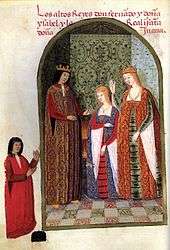
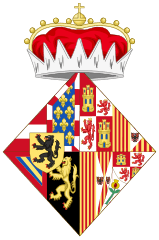

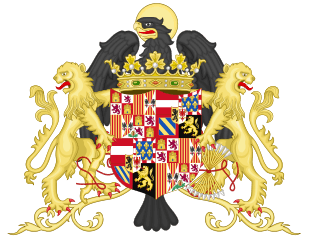

.svg.png)
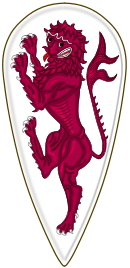
.svg.png)